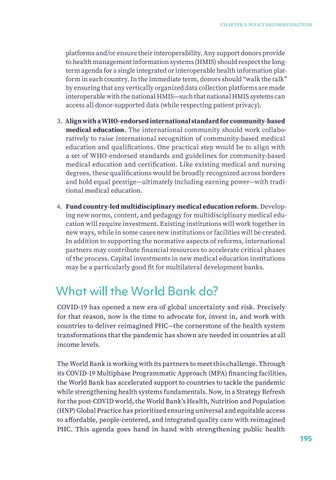CHAPTER 5: POLICY RECOMMENDATIONS
platforms and/or ensure their interoperability. Any support donors provide to health management information systems (HMIS) should respect the longterm agenda for a single integrated or interoperable health information platform in each country. In the immediate term, donors should “walk the talk” by ensuring that any vertically organized data collection platforms are made interoperable with the national HMIS—such that national HMIS systems can access all donor-supported data (while respecting patient privacy). 3. Align with a WHO-endorsed international standard for community-based medical education. The international community should work collaboratively to raise international recognition of community-based medical education and qualifications. One practical step would be to align with a set of WHO-endorsed standards and guidelines for community-based medical education and certification. Like existing medical and nursing degrees, these qualifications would be broadly recognized across borders and hold equal prestige—ultimately including earning power—with traditional medical education. 4. Fund country-led multidisciplinary medical education reform. Developing new norms, content, and pedagogy for multidisciplinary medical education will require investment. Existing institutions will work together in new ways, while in some cases new institutions or facilities will be created. In addition to supporting the normative aspects of reforms, international partners may contribute financial resources to accelerate critical phases of the process. Capital investments in new medical education institutions may be a particularly good fit for multilateral development banks.
What will the World Bank do? COVID-19 has opened a new era of global uncertainty and risk. Precisely for that reason, now is the time to advocate for, invest in, and work with countries to deliver reimagined PHC—the cornerstone of the health system transformations that the pandemic has shown are needed in countries at all income levels. The World Bank is working with its partners to meet this challenge. Through its COVID-19 Multiphase Programmatic Approach (MPA) financing facilities, the World Bank has accelerated support to countries to tackle the pandemic while strengthening health systems fundamentals. Now, in a Strategy Refresh for the post-COVID world, the World Bank’s Health, Nutrition and Population (HNP) Global Practice has prioritized ensuring universal and equitable access to affordable, people-centered, and integrated quality care with reimagined PHC. This agenda goes hand in hand with strengthening public health 195


